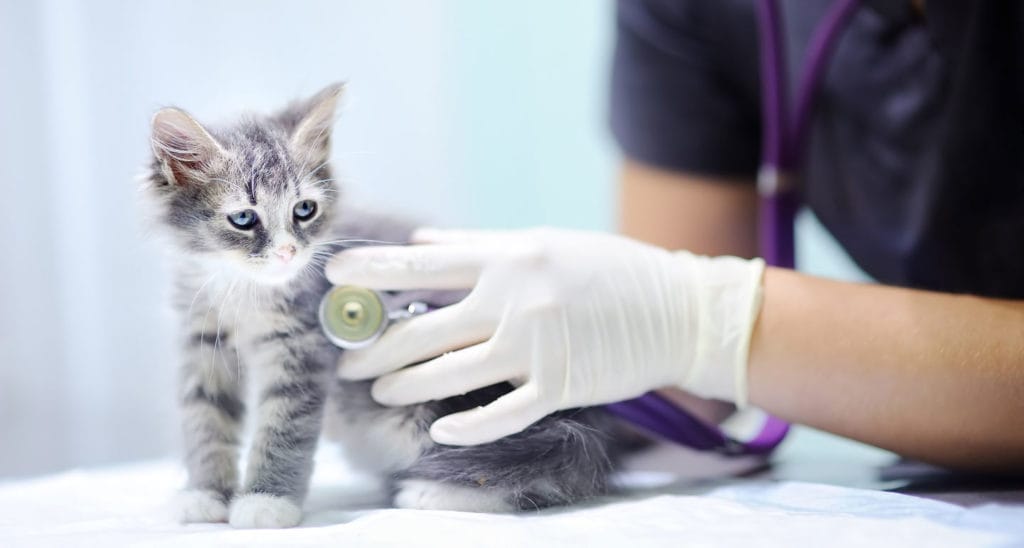It’s estimated that 48 percent of cat parents do not take their feline pets to the vet for an annual visit. To those of us who have coaxed an “I know something’s up” fearful kitty out from under a bed and into a carrier only to be treated to plaintive howls and hisses all the way to a vet appointment, the “why” is maybe no big mystery.
But a yearly visit (more often for kittens and older cats) to a veterinarian is a non-negotiable for your pet’s good health and wellbeing. This is especially essential for cats, a species that can be skilled at hiding potentially deadly diseases and illnesses.
Fortunately, this gotta-do-it appointment doesn’t have to devolve into who can cry louder—you or your cat. Start right now learning a few insider tips and tricks for taking a cat to the vet (and maybe a few for you, the human, too), and your next trip will be the cat’s meow.
Why Taking a Cat to the Vet Can Be So Stressful
First, let’s take a stroll through the inner working of the feline brain. “Cats are solitary hunters and solitary survivors. This pretty much explains all you need to know about their behavior,” says Dr. Liz Bales, VMD. “Be safe. Be fed. Stay alive. Nature has set cats up to think that anything new will kill them. This is how they see the world.”
Now, knowing that cats are hardwired for fight or flight, consider all they go through during a trip to a vet—everything from being shoved into a plastic box and driven on a bumpy car ride to a place that smells and sounds scary with people who need to handle you. It’s not hard to understand why their reactions can range from extreme panic to aggression.
“A single experience with a stressor can have a long-lasting effect on a cat and can lead to worsening of fear and stress in the future,” explains veterinary behavior resident Dr. Alison Gerken, DVM, of the Florida Veterinary Behavior Service. “So, approaching how we do our first vet visit is very important, and creating a reward-based experience is a great place to start.”
Creating a Great Cat Vet Visit Vibe
Now that you know why you may have a stressed cat on your hands, it’s time to learn what you can do to help. The key to creating a less-stressful cat vet visit is… drumroll, please… preparation. First, you need to get your cat used to their carrier. Then, take the proper steps the day before and the day of the visit to limit triggers—for you and for your pet.
Getting Geared Up
When a cat is scared, they want to be in “the smallest possible space that smells like them,” says Dr. Bales. “This is why making a pet carrier your cat’s BFF is an important first step.” It’ll be a slow burn, but worth it in the end
- Begin “carrier training” by leaving carrier with the door open in a room where you spend lots of time.
- Remove the bedding (or supply beddings, such as K.T. Manufacturing's cat mat) and gently rub your cat with the fabric when they are relaxed. The bedding will begin to smell like them when they are happy.
- Next, place a few pieces of a treat your cat loves inside carrier every single day so they associate inside the carrier with good things.
- Every 60 days close the carrier with the cat inside and leave them for a few minutes with a few extra treats.
- In six months after the start of training, leave you cat inside the carrier and walk around for a few minutes then let the out.
- Finally, once all is going well, take a short ride with the carrier tucked behind the passenger’s seat.
- If you have to skip some steps, just get complete carrier out now and feed them anything you can inside with a comfortable bed inside. Don’t push cat inside—remember, they’re nosy by nature.
In the end, “your cat should no longer see the carrier as a sign that something bad is about to befall them,” Dr. Bales says. “Instead, it’s a happy place with familiar smells and tasty treats.”
Before Your Cat’s Vet Visit
The best way to short circuit any potential drama is to think ahead. Dr. Gerken suggests finding a clinic that has separate entrances for cats and dogs, and then scheduling the first appointment of the day when the clinic is likely to be quieter. Call the day before and let the desk know that your pet is fearful and that you prefer to wait in your car until an exam room is ready. (They’ll call or text when the room is ready.) And, let the staff know that you are bringing your cat's favorite treat. (Try American Journey 100% Chicken Freeze-Dried Grain-Free Cat Treat.) All of this can help to create a seamless sense of calm.
If you know from past experience that you anticipate a fearful cat, Dr. Gerken recommends consulting with your veterinarian about prescribing appropriate medications, such as Gabapentin or Zylkene, that can be taken prior to the scheduled visit. Or consider over-the-counter solutions, such as Feliway, that can be sprayed into the crate before the trip to the appointment.
During Your Cat’s Vet Visit
While a two-piece carrier (where the lid is a separate piece), like this cat carrier from Frisco, makes it easier to get your cat out once in the exam room, whichever carrier your choose, just remember to take this slow. Give your cat a few minutes to adjust to the new sights, sounds and smells. Keeping your voice low and soft and offering a few familiar food treats can help, advises Dr. Bales.
After Your Cat’s Vet Visit
When it’s finally time to head home, your cat will likely need some time to chill out. “At this point it’s likely your cat’s stress neurochemicals, such as cortisol, are spiking and need time to return to baseline,” says Dr. Bales. “Once inside [your home], the best thing to do is nothing. Just let your cat do her thing.” More than likely your cat will retreat to her favorite hidey-hole emerging when the time feels right. “Humans are pack animals and we look for support from others when we are feeling stressed. Cats? They just want to be alone.” For multi-cat household where reintroduction can be critical, she advises putting Kitty in a closed, private space and then slowly reintroduce them to the household.
If instead of hiding your cat shows aggression (biting, clawing, hissing), just know that they are communicating stress. Dr. Gerken says it’s not retribution but rather “distance increasing behavior”—if your cat is crouched in a “meatloaf” position with tightly curled tail, ears back, no eye contact, these are early signs. Listen to this and know to back off.
Things should return to normal in a day or less but, according to Dr. Gerken, be aware of your cat not eating after a vet visit. More than 24 hours is reason for concern. Bring food to your cat, and if they turn up their nose, try a soft cat food treat, such as Churu lickable treats, that have a strong smell.
Now, Let’s Talk About You
Our intensity and apprehension can be part of the reason our cat is a strung-out furry mess. We asked Karin Weiri, a licensed family therapist based in DeLand, Florida who specializes in anxiety, for some coping strategies for us humans when taking a cat to the vet.
- First, Weiri advises getting a handle on what is worrying you. Financial costs? Not knowing what to expect? Being judged by the vet? Thinking your cat will cat hate you? “These are all rational responses to the situation,” says Weiri. “Focus on times where you were strong and felt empowered and then, ask your questions. Keep a journal so you won’t forget. And try to remember, these people like cats!”
- Next, set yourself up for success by changing the horror movie playing on every screen in your mind. Before the appointment, take time to center yourself by running a video in your head of how you want things to go—you’re calm and relaxed, everyone is safe and sound, and in an hour or so, you’re out of there and done for the year.
- What if your cat’s vet visit actually does go south? Acknowledge it and move on. “It’s OK to feel sad, mad, embarrassed, and those emotions might bubble up. Feel them and then release it,” says Weiri, who recommends trying heart-centered meditation to relax and re-center. “Put your hand on your heart and focus on the love you have for your cat, and just feel that love emanating until you fill the room with it. Your cat will feel this energy.”
Finally, Weiri reminds us that our brains look for obstacles and threats, so we have to train ourselves to look at it from a different way. “Use this as an opportunity to get better educated and be better able to handle those big emotions next time,” she says. “And remember that everyone is perfectly-imperfect—and we all are just learning.”
Share:















